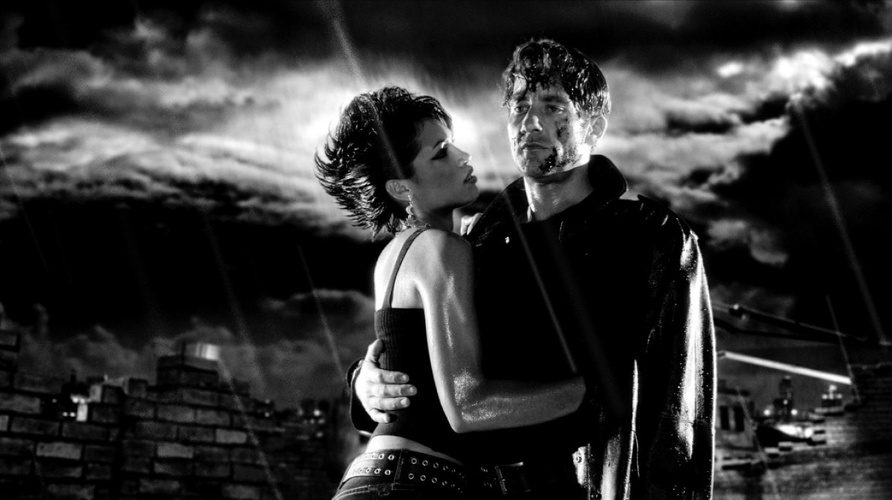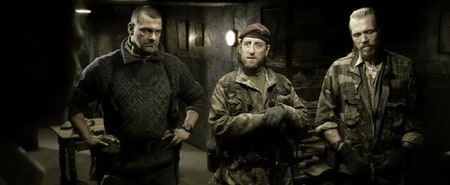Masterminded by indie filmmaker Robert Rodriguez (Desperado, From Dusk Till Dawn), 2005's Sin City is the most definitive cinematic translation of a graphic novel to date. Rodriguez adapted the movie from the pages of the iconic Frank Miller's neo-noir comic book series of the same name, resulting in an indisputable masterpiece boasting gorgeously stylised visuals of a violent, monochrome world inhabited by ruthless villains and compelling anti-heroes. Sin City is the ultimate proof that comic book movies are not inherently for children, as these blood-soaked stories are brutal, repugnant and sadistic. However, Sin City is a visually enthralling blast from start to finish for those able to stomach this material. Rodriguez's graphic novel adaptation is also a compelling showcase for the possibilities of digital moviemaking (kick-started by 2004's Sky Captain and the World of Tomorrow), wherein actors appear within computer-generated environments. Due to this, the film sparked an entire new comic-to-screen aesthetic, leading to movies like Zack Snyder's 300 and the Frank Miller-directed The Spirit.

"Sin City" is the appropriately shortened name for Basin City, the seedy metropolis where the proceedings occur. An anthology narrative, Rodriguez packs together three of Miller's stories - The Hard Goodbye, The Big Fat Kill, and That Yellow Bastard - and bookends them with the short story The Customer Is Always Right. In The Hard Goodbye, a hulking thug named Marv (Mickey Rourke) spends the night with an angelic woman named Goldie (Jaime King), but a silent, unseen assailant murders her during the night. Framed for the murder and wanting revenge, Marv seeks answers, leading him to a mute serial killer, Kevin (Elijah Wood), who is part of a larger conspiracy. The Big Fat Kill concerns Dwight McCarthy (Clive Owen), who wants to protect his girlfriend, Shellie (Brittany Murphy), from her abusive former lover, the immoral Jackie Boy (Benecio del Toro). Jackie Boy and his cronies drive across the city to Old Town, where they have a run-in with a group of dangerous, lethal prostitutes led by Gail (Rosario Dawson). In That Yellow Bastard, aging police officer John Hartigan (Bruce Willis) is sent to prison after saving young Nancy Callahan (Jessica Alba) from a serial child-killer, Junior (Nick Stahl), the son of corrupt politician Senator Roark (Power Boothe). After his eventual release several years later, Hartigan searches for the now-adult Nancy, unaware he is falling into Junior's trap.
Brought to life practically verbatim from Miller's strikingly illustrated graphic novels, the stories here are admittedly familiar-feeling and unremarkable on paper as they incorporate noir tropes and conventional characters. But Sin City shines in its execution, from the incredible aesthetics and enthralling sense of atmosphere to the top-notch casting and unique dialogue verbiage. Robert Rodriguez did not devise any script or storyboards for this feature-film iteration - instead, the filmmaker referred to Miller's comics during the production, taking the term "faithful adaptation" to a new and more literal level. As written by Miller, the dialogue and hard-boiled noir-esque voiceovers crackle with lyricism and badassery, while veteran action filmmaker Rodriguez handles the vehemently R-rated moments of gunplay and action with utmost panache and confidence. Like the comics, Sin City is not for all tastes as an omnipresent sense of the macabre and seediness permeates practically every frame, and there is plenty of brutal violence and gratuitous nudity that the easily offended or those with weak stomachs cannot consume comfortably. Nevertheless, this is true to the source, and the movie is legitimately exciting, engaging, and intense. In other words, it is not mindless, tasteless violence porn.

Visually and atmospherically, Sin City is a masterpiece. Serving as his own cinematographer, Rodriguez shot the picture with digital cameras in front of green screens to seamlessly facilitate the computer-generated backgrounds. Rodriguez's extraordinary black and white cinematography also benefits from stylish lighting and shadows, meticulously turning Miller's comic panels into captivating cinematic frames. The visuals are predominantly monochrome with small bursts of colour, resulting in a unique palette that filmmakers continue to emulate. There are plenty of visual nuances to behold here, including silhouettes in some shots to further solidify the picture's comic book origins. The budget for Sin City was relatively modest at $40 million, yet the special effects and compositing still stand up to scrutiny after twenty years. Another huge asset is the atmospheric and memorable score credited to Rodriguez, John Debney, and Graeme Revell, which adds more life and colour to the production. Rodriguez and Miller worked as a team to direct the movie, trimming small bits from the comics to generate the gloriously brisk pace. Frequent Rodriguez collaborator Quentin Tarantino even receives a "Guest Director" credit - he helmed the scene between Clive Owen and Benicio del Toro as they drive to the tar pits.
The casting constitutes another of Sin City's greatest strengths, as Rodriguez and Miller recruited a sensational ensemble. Despite the film featuring several big-name actors, nothing feels like senseless stunt casting for maximum box office, and none of the actors try to overshadow each other; instead, it's a genuine ensemble effort. The highlight is Mickey Rourke, who is in full career-resuscitating mode here as the ruthless Marv. With elaborate make-up to closely resemble his comic book counterpart, Rourke is a passionate and compelling scene-stealer, and this ranks as the actor's best work to date. Clive Owen is another highlight as the charismatic and capable Dwight, while Bruce Willis is enormously memorable as the hardened, aging Hartigan. Despite Willis playing a cop, he does not play another variation of his wisecracking John McClane screen persona; instead, his performance is far edgier and darker.

Other notable performers include Power Boothe as the corrupt Senator Roark and Rutger Hauer as Cardinal Roark, while the monstrous Michael Clarke Duncan also makes a great impression as the nearly indestructible Manute. Meanwhile, Josh Hartnett appears as an assassin at the beginning and end of the movie, and Elijah Wood (who worked with Rodriguez on The Faculty) plays against type as a sadistic, cannibalistic murderer, a far cry from his wholesome performances in films like The Lord of the Rings and Flipper. There are many other terrific actors here - including Michael Madsen as a detective, Devon Aoki as a mute assassin, Brittany Murphy as Shellie, and Benicio del Toro as an unsavoury douchebag - but suffice it to say, there is not a single weak link in the ensemble.
With strict rules about directorial credits, Rodriguez specifically resigned from the Directors Guild of America to credit Miller as co-director on the movie, which also led to his dismissal from the film John Carter as Rodriguez could no longer direct major studio pictures. This bold move reflects Rodriguez's dedication to bringing Miller's vision to the screen in the most faithful way possible, collaborating on-set and referring to the pages of his graphic novels to create something truly special. With its engaging narrative structure, breathtaking visuals and badass noir dialogue, Sin City is a uniquely spectacular cinematic experience. The movie is also thrilling and unpredictable, as Rodriguez and Miller incorporate shocking deaths and multiple gut-wrenching climaxes. Sin City is perfection, and it is difficult to imagine any existing fans not being satisfied with this exemplary effort (it should also earn Miller new fans), especially with the availability of Rodriguez's recut, extended and unrated edition that presents each story separately with additional material. After years of rumours and delays, a sequel, Sin City: A Dame to Kill For, was released in 2014, nine years after its predecessor.
10/10
 Login
Login
 Home
Home 183 Lists
183 Lists 1671 Reviews
1671 Reviews Collections
Collections
 0 comments,
0 comments, 


































